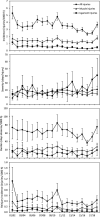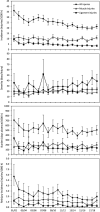Injury rates decreased in men's professional football: an 18-year prospective cohort study of almost 12 000 injuries sustained during 1.8 million hours of play
- PMID: 33547038
- PMCID: PMC8458074
- DOI: 10.1136/bjsports-2020-103159
Injury rates decreased in men's professional football: an 18-year prospective cohort study of almost 12 000 injuries sustained during 1.8 million hours of play
Abstract
Background: The UEFA Elite Club Injury Study is the largest and longest running injury surveillance programme in football.
Objective: To analyse the 18-season time trends in injury rates among male professional football players.
Methods: 3302 players comprising 49 teams (19 countries) were followed from 2000-2001 through 2018-2019. Team medical staff recorded individual player exposure and time-loss injuries.
Results: A total of 11 820 time-loss injuries were recorded during 1 784 281 hours of exposure. Injury incidence fell gradually during the 18-year study period, 3% per season for both training injuries (95% CI 1% to 4% decrease, p=0.002) and match injuries (95% CI 2% to 3% decrease, p<0.001). Ligament injury incidence decreased 5% per season during training (95% CI 3% to 7% decrease, p<0.001) and 4% per season during match play (95% CI 3% to 6% decrease, p<0.001), while the rate of muscle injuries remained constant. The incidence of reinjuries decreased by 5% per season during both training (95% CI 2% to 8% decrease, p=0.001) and matches (95% CI 3% to 7% decrease, p<0.001). Squad availability increased by 0.7% per season for training sessions (95% CI 0.5% to 0.8% increase, p<0.001) and 0.2% per season for matches (95% CI 0.1% to 0.3% increase, p=0.001).
Conclusions: Over 18 years: (1) injury incidence decreased in training and matches, (2) reinjury rates decreased, and (3) player availability for training and match play increased.
Keywords: elite performance; epidemiology; hamstring; injury prevention; soccer.
© Author(s) (or their employer(s)) 2021. Re-use permitted under CC BY-NC. No commercial re-use. See rights and permissions. Published by BMJ.
Conflict of interest statement
Competing interests: None declared.
Figures



References
-
- Dupont G, McCall A. Targeted systems of the body for training. In: Strudwick T, ed. Soccer science chapter 11. Human kinetics, 2016: 221–47.
-
- Arnason A, Sigurdsson SB, Gudmundsson A, et al. . Physical fitness, injuries, and team performance in soccer. Med Sci Sports Exerc 2004;36:278–85. 10.1249/01.MSS.0000113478.92945.CA - DOI - PubMed
-
- Wv M, Hlobil H. Incidence, Severity, aetiology and prevention of sports injuries. Sports Med 1992;14:82–99. - PubMed
MeSH terms
LinkOut - more resources
Full Text Sources
Other Literature Sources
Medical
